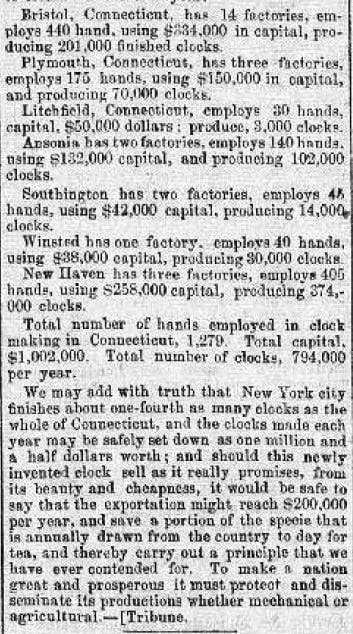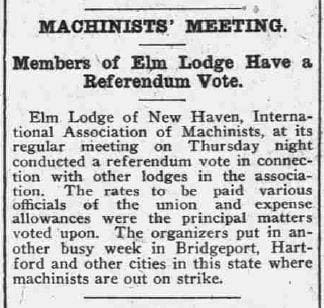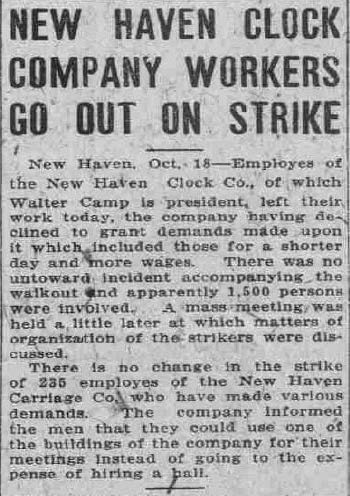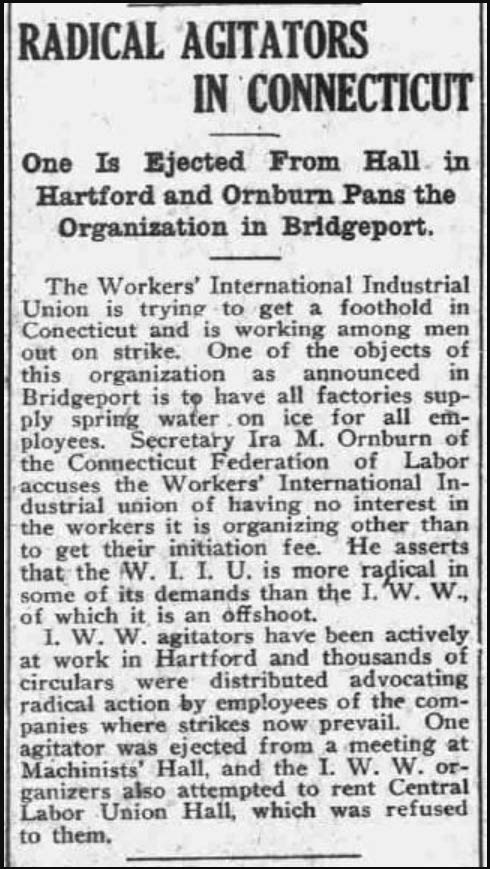New Haven Clock Company Factory: History and Industrial Networks Through Time
Rukshan Vathupola (2019)


German Style Movements has been popular in Europe but were relatively new to America during the time when Chauncey Jerome discovered them in use in Virginia in the mid 19th century and incorporated them to create the brass movement. The brass movement proved superior to the wooden movements of the day for two reasons. Wooden movements could warp and deflect with the temperature and climate allowing those clocks to easily malfunction. Jerome also devised a method to create the brass gears by stamping them instead of casting them in an industrial mold.
Mahogany used to create the wooden casework was grown, cut and shipped from forests in central Southern America mainly from the forested Amazonian region of Brazil. In the 1851 it was recorded that nearly 300,000 feet of mahogany was imported for the purpose of was imported along with rosewood and nearly 1.5 million feet of pine lumber.
Ever since the early 1840’s the founder of the New Haven Clock Company Chauncey Jerome has established networks to the regions of the British Isles, British India and Canada as well as Peru, the Ottoman Empire and Qing Dynasty China. Nearly 75,000 clocks were being produced each year along with nearly 150,000 to 176,000 movements. And almost $100,000.00 in wages was being paid per month to nearly 405 workers.
Using his power as Mayor of New Haven in 1854 Jerome was even able to negotiate the lowering of tariffs on American Clocks from 20% to 10% to England and the British colonies, which made up a substantial share of the global market for the company.


Most components were sourced from around the North, but some were shipped south for assembly due to state regulations.
The glass work for many of the wooden casework is treated with a cotton product known as Pryalin. The cotton came from the Southern states, it was then sent to be processed in New Jersey and later manufactured into Pryalin before being sent to industrial centers such as New Haven.
Glass work used for much of the crystals and decorative door panels for the clocks was produced in Pennsylvania and then shipped to Connecticut. The earliest glass and iron workers to Eastern Pennsylvania came from Sweden after an appeal was made the Scandinavian settlers to the King to send talented artisans to the New World. This changed after William Penn established the Free Society of Traders to establish trade and manufacturing networks to enrich the the economic position of the colony and utilizes it’s natural resources.
During the mid-19th century many Southern workers and industries did not like the fact that the North was able to industrialize much faster and produce goods at larger quantities and lower prices. Due to this, several laws were passed to ensure that only Southern made products could be sold within certain states. To get around this, the New Haven Clock Company would ship workers and clock parts to states such as Virginia where the clocks would be assembled and be marketed as Southern made clocks
In the location of workers throughout the state the main ares are centered in New Haven and Bristol, with slightly smaller congregations of workers in outlying areas such as Ansonia and Plymouth. By being closer to international centers of immigration such as New York and by being on the water it was easier for people to more easily migrate and settle along the coasts of Connecticut rather than traveling inland. This allowed different ethnic neighborhoods to establish which furthered the ease of access for other immigrants to settle in the area.



Connecticut Tribune, 1854
The right map correlates the cities in Connecticut in relation to the amount of clock factories. During this time Bristol had the greatest amount of factories in the region, but this was due to a large amount of small scale workshops as noted by the fact that although New Haven had only 3 factories they had almost as many workers among them and still managed to create many more clocks per year.
In the network of the production of clocks nearly half of the 794,000 made every year were produced in New Haven with a gradual decrease in the amount of production being noted as we go further inland. New Haven was able to capitalize on the adjacently to the ocean as it allowed for the faster and cheaper import of raw material and fuel for factories, allowing them to grow faster and to a larger scale
With profits made from the New Haven Clock Company the founder Chauncey Jerome donated money for the building of a Congregationalist Church during the mid 19th century on Wooster Square. Known as Jerome’s Church for several decades it unfortunately caught fire and burnt down after having been hit by lightning twice. It was soon rebuild and consecrated as a catholic church for the growing Italian commonality of New Haven under the name of St. Micheal’s which stands to this day.
Looking at the local networks the New Haven Clock Company facilitated was done in sequences. During the late 19th century and the early 20th century the factories would provide a job for life as well as develop community resources for its workers such as baseball teams, housing, shops and in this case a church.
During the mid 1800’s Chauncey Jerome became the Mayor of New Haven from 1854-55. During this time he entered in international politics by convincing the British delegation to the United States to lower the tariff on all American made clocks from 20% to 10% to be shipped to England and the subsequent British colonies of Canada and India.



Connecticut Labor News, Aug. 21, 1923
During the early part of the 20th century baseball was one of the most popular sports to play in New Haven. There were nearly 30 professional and amateur teams, coupled with the industrial and working class background of the city many factories began to establish employee run teams. This eventually led to the development of the New Haven State Industrial League, one of several baseball leagues that existed in the first half of the 20th century centered in factory cities throughout the United States. Looking at the records for the names of the workers during this time they come very diverse European backgrounds. Many of these families would have come in the early 20th century or the latter half of the 19th century as a result for several turmoils during the mid 1800’s. The the Irish population dropped nearly by
a quarter and the Swedish fell nearly
by 10 percent. After the Italian war for
unification broke down the medieval
feudal system many Italians left for
North and South America. This was
mirrored in Germany with several initial revolutions in 1848 with the eventual unification of Germany in 1871, but the
ensuing conflicts did cause many Germans to leave for the Americas. Polish immigration
was seen as a result of the partition of Poland that rendered it non-existent by absorbing it
into the empires of Germany, Austria-Hungry and Russia.

Strike!






Headlines from the Connecticut Labor News describing organized labor actions in the Clock Co. Factory

